Why LED lamps light when the switch is off: reasons and solutions
You do not know why the LED lamps light when the switch is off? Agree: few people will please the problems in the functioning of the lighting system. Do you prefer to find the cause of the glow of the LEDs yourself, without involving an electrician? However, you do not know where the weak spot is?
We will show you how to deal with a difficult problem. The article describes the most common situations that cause the lamps to glow after they are turned off. Ways to solve the problem are considered, recommendations are given for choosing a reliable light source from a trusted manufacturer.
The measures recommended by us will allow us to avoid a number of difficult situations during the further operation of such devices. The special design of the LED luminaires guarantees an economical consumption of electricity and a long service life.
The content of the article:
LED lamp design
In order to find out the cause of the glow of the device after turning it off, you need to carefully consider the device of the LED device, and also find out the principle of its operation.
The design of such a lamp is quite complicated; It consists of the following elements:
- Chips (Diodes). The main element of the lamp, providing radiation of a stream of light.
- Printed aluminum circuit board on thermally conductive mass. This component is designed to remove excess heat into the radiator, due to which the device maintains the temperature necessary for the correct operation of the chips.
- Radiator. A device to which heat is supplied from the other nodes of the LED lamp. Usually this part is made of anodized aluminum alloy.
- Basement Lamp base for connecting to a lamp socket. Typically, this element is made of brass, coated on top with a layer of nickel.The deposited metal counteracts corrosion while promoting contact between the instrument and the cartridge.
- Base. The lower part adjacent to the base is made of polymer. Due to this, the case is protected from penetration by electric current.
- Driver. A node that provides stable uninterrupted operation of the device even in the case of a sharp change in the indicators of voltage drops in the electrical system. The functioning of this unit occurs similarly to a galvanically isolated modulator of an electric current stabilizer.
- Diffuser. Glass hemisphere covering the device from above. As the name implies, the part is designed to maximize the dispersion of the light flux that the diodes emit.
All nodes of the device are connected to each other, which ensures its reliable operation.
The principle of operation of the equipment
The specific circuitry of LED devices manufactured by various manufacturers can vary significantly. However, all of them are based on the general principle of operation, which can be schematically displayed as follows.
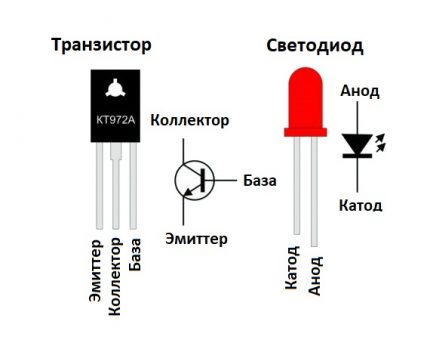
When turned on led lampconnected to the mains, the chaotic movement of electrons begins inside the container. Colliding with each other and with holes in the pn junction region — the contact of two semiconductors with different types of conductivity — the particles are converted into photons, due to which light emission occurs.
To optimize the process, additional devices can also be used, for example, different types of resistors or current-limiting elements.
Pros and cons of LEDs
Such products have gained popularity among the population, thanks to a number of positive qualities. Their main advantage is profitability: the lamps have a long service life, which is confirmed by warranty for three years. In addition, their functioning requires a minimum amount of energy.
An important advantage is environmental safety. LED devices do not emit ultraviolet waves, which can harm living organisms. Hazardous materials are not used in their design, which facilitates disposal.
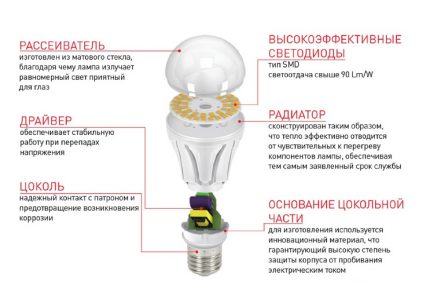
The disadvantages of LED-devices in the first place include high cost. It should also be noted that their work has specific features: sometimes LEDs blink or do not turn off even after the switch is turned off.
These shortcomings are caused by the conservation of charge, which accumulates in the capacitor. A weak pulsating current leads to blinking, and a stronger one creates a long glow.
How harmful are burning lamps?
As mentioned above, one of the most common violations in the operation of LEDs is the inability to completely turn off the light source. The lamps continue to burn, using approximately 5% of normal power for several minutes or even hours.
Sometimes dim lighting tires the inhabitants of apartments, but some use muffled burning lamps as nightlights.
It is worth adding that the defect does not adversely affect the wiring condition, and the energy consumption increases very slightly, since the LEDs consume a small amount of electricity.
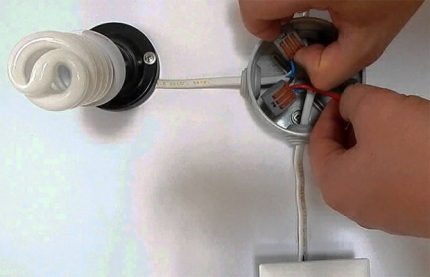
Nevertheless, experts advise to fix the problem as soon as possible, since the residual luminescence of the LEDs significantly reduces their service life.In addition, the causes of this phenomenon can lead to serious trouble.
The main causes of residual glow
The reasons that trigger the burning of LEDs can be different.
Among the most common include:
- Problems associated with the wiring, which is laid in the apartment. This may be a broken section of the circuit or a violation of the insulation of one of the wires.
- Incorrect wiring diagram for the device to the switch or switchboard.
- The use of a backlit switch, as well as the use of other difficultly compatible devices: sensors, modules, timers, etc.
- Low quality of used devices or individual features of models.
Below we will consider each of the reasons in detail, also indicating measures that contribute to solving problems in various cases.
Reason # 1 - switch with backlight option
If you encounter a problem of constantly burning lamps, you should first look at the switch. According to electricians, the most common cause of this phenomenon is the use of backlit switch.
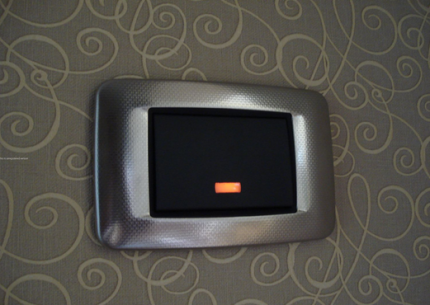
In this case, the devices come into conflict: even an off switch cannot fully open the circuit due to the backlight, which is fed through the resistance. Since the system remains open, a small voltage reaches the lamp, which causes a dim glow.
Similar problems can be caused when using other electrical devices: photocells, timers connected to lamps motion sensors and light.
The way to solve this problem. Since such a defect with LED lamps that burn even when the switch is off is quite common, electrical specialists have gained extensive experience in correcting the situation.
These may be the following options:
- circuit breaker replacement;
- backlight off;
- installation of an additional resistor;
- replacing one of the lamps in the chandelier with a weaker analogue;
- the use of resistance with a large power indicator.
The easiest way is to replace the backlit switch with standard switch model without additional function. However, this decision is associated with additional cash costs, as well as with the reinstallation of the device.
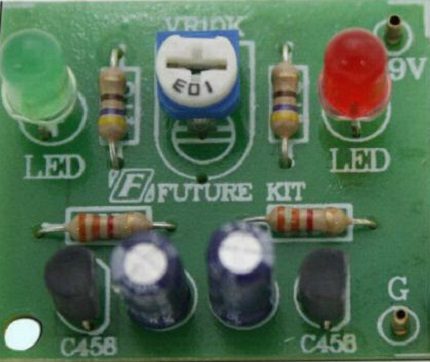
If the presence of the backlight on the switch is not essential, you can simply bite the resistance with the pliers, which sets the power supply for it. Adding a shunt resistor will help to turn off the LED while maintaining the backlight. A device with a resistance exceeding 50 kOhm and a power of 2-4 W can be purchased at a specialized store.
To connect it, you need to remove the ceiling from the lamp, and then attach the wires extending from the device to the terminal strip with network cores, which will allow you to connect in parallel with the lamp.
In this case, the current passing through the LED will not flow through the driver capacitor, but through the newly connected node. As a result, the reactance recharging stops and the LEDs turn off when the switch is turned off.
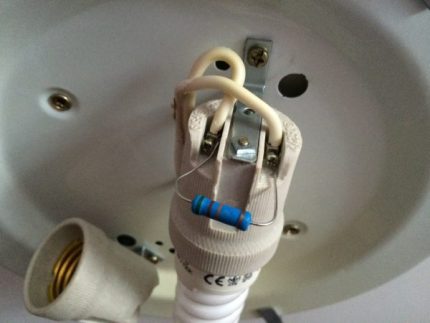
If the problem is identified in a multi-track chandelier, you can install an incandescent lamp in one of the departments with a minimum power that will collect all the current coming from the capacitor.
A similar solution can be applied to a single-track chandelier by installing an adapter with one to two cartridges. At the same time, when using this method, a faint luminescence of one light bulb will nevertheless remain.
The desired result will also be obtained by replacing the usual resistance in the switch with its analog with a large number of ohms. However, to perform such manipulations, you will need to consult an electrician.
Reason # 2 - electrical wiring malfunctions
Quite often, the source of non-switching off lamps is a failed wiring. If a violation of insulation is suspected, it is necessary to apply a high voltage to the device for several minutes to simulate the conditions causing breakdowns in the electrical network.
To find the place of damage to the hidden cable, you can also use homemade or professional products designed for this purpose.
If the problem really is worn insulation, the apartment must partially or completely replace the wiring. With the cable routing open, the process will take a minimum of time and effort. More difficult work is to be done if hidden wiring walled in the walls was installed in the housing.

In this case, decorative surfaces, for example, wallpaper, as well as plaster, will have to be removed from vertical surfaces. After opening the gate, where the wires are located, the entire cable or damaged area is replaced. In conclusion, it is necessary to seal the canals with gypsum, and then plaster and re-finish the walls.
An alternative temporary solution may be to connect to the network of the device, for example, a resistor or relay, which gives additional load. Similar devices, whose resistance is weaker than that of LEDs, are connected in parallel to the luminous lamps.
In this case, the current is redirected, due to which the operation of the LED devices is regulated: the light goes out immediately after the switch is turned off. The newly connected element will also not function due to the low resistance value.
Reason # 3 - incorrect connection of the lamp
The cause of continuous burning of the lamp may be hidden in connection errors. If during the installation of the switch a zero was connected instead of a phase, it will turn off when the circuit is opened.
At the same time, due to the preserved phase, the wiring will still be energized, due to which the device will glow when the switch is turned off.
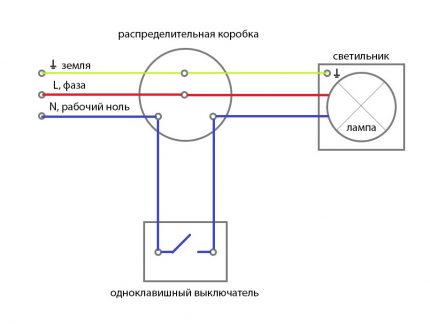
This situation is quite dangerous for the inhabitants of the apartment: since the device is energized, even if it is turned off, you can accidentally receive an electric shock. To remedy the situation, it is necessary to turn off the power supply, then disconnect the wires, and then mount them correctly.
Reason # 4 - poor quality light bulbs
Quite often, the cause of the malfunction is the poor quality of the LED used, which must be replaced with a working one. In order to encounter such problems as rarely as possible, it is better to buy certified products of such brands as PhilipsGauss or ASD,
Well-established Russian brand products Jazway and era.
True, the conservation of luminescence can also be observed in devices manufactured by reputable manufacturers. It can be caused by functional features in the operation of lamp resistors.
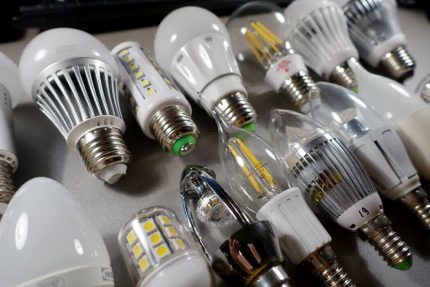
So, when an electric current is supplied, thermal energy can accumulate in the device, due to which the LED will light up after turning off, however, for a short time. Companies are struggling with this phenomenon using resistors made of materials that prevent the accumulation of excess heat in the manufacture of equipment.
Recommendations for choosing electrical appliances
One of the important factors for the smooth operation of LED lamps is the selection of products of proper quality. In this case, you should take into account the features under which they will have to operate the devices, as well as their compatibility with other equipment connected to the mains.
Before buying, it is recommended that you carefully read the instructions attached to the LED devices, which indicate the operating rules. It should be noted that a number of popular devices, such as LED dimmers, timers, PV modules can cause malfunctions in the LEDs.
It is also important to carefully examine the appearance of the bulb, paying attention to the junction between the housing and the base, which must reliably and without any defects adjoin the main part. If there are scratches, dents or a sloppy seam, the likelihood of problems with the glow increases significantly.
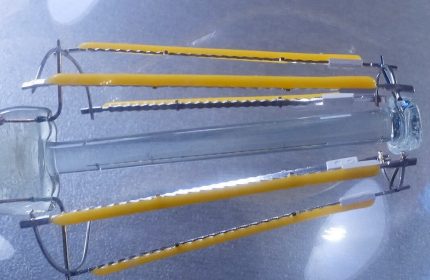
An element such as a radiator is important. It is best to choose an LED in which it is made of aluminum, however, ceramic and graphite analogs also have high characteristics. The size of this part, which is responsible for the removal of thermal energy, the release of which can occur when the light is off, is also important.
For the high-power LED to work correctly, you need to use a large heatsink, while a compact device is enough for a weak device.
As a rule, in specialized stores, sellers test the lamp on. In this case, you need to try to check the level of flicker: the lighting device should emit a steady light stream without any ripple.
Since it is quite difficult to evaluate this factor with the naked eye, it is better to photograph the turned-on device on the camcorder of a mobile phone. Recording will allow you to better evaluate its work.
Conclusions and useful video on the topic
The video reveals the two most common causes of LED lamp burning even after turning off the power. Detailed instructions are also provided for resolving them:
The glow of the lamps when the switch is off is not only unpleasant for the eyes, but also dramatically reduces the life of the LEDs. To fix the problem, you need to establish the cause that causes the malfunction of the devices, and then eliminate it.
In most cases, it will take a minimum of time and effort to correct the situation. Necessary work can be done independently using elementary tools.
Please leave comments in the block below. Share useful information that may be useful to site visitors. Ask questions, tell about your personal experience in eliminating LED information after turning it off, publish a photo on the topic of the article.

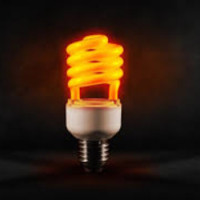 The lamp blinks when the switch is off: causes and solutions
The lamp blinks when the switch is off: causes and solutions 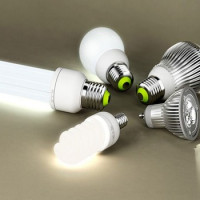 Why the LED bulbs blink: troubleshooting + how to fix
Why the LED bulbs blink: troubleshooting + how to fix 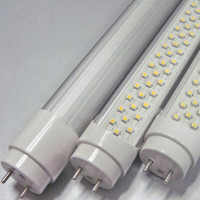 Replacing fluorescent lamps with LEDs: the reasons for the replacement, which are better, replacement instructions
Replacing fluorescent lamps with LEDs: the reasons for the replacement, which are better, replacement instructions 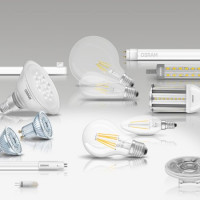 Osram LED lamps: reviews, advantages and disadvantages, comparison with other manufacturers
Osram LED lamps: reviews, advantages and disadvantages, comparison with other manufacturers 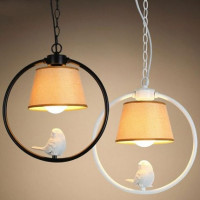 220V LED lamps: characteristics, marking, selection criteria + review of the best brands
220V LED lamps: characteristics, marking, selection criteria + review of the best brands 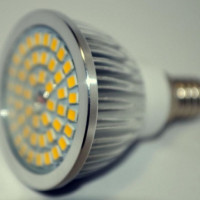 LED lamps "Era": reviews about the manufacturer + a brief overview of the model range
LED lamps "Era": reviews about the manufacturer + a brief overview of the model range  How much does it cost to connect gas to a private house: the price of organizing gas supply
How much does it cost to connect gas to a private house: the price of organizing gas supply  The best washing machines with dryer: model rating and customer tips
The best washing machines with dryer: model rating and customer tips  What is the color temperature of light and the nuances of choosing the temperature of the lamps to suit your needs
What is the color temperature of light and the nuances of choosing the temperature of the lamps to suit your needs  Replacement of a geyser in an apartment: replacement paperwork + basic norms and requirements
Replacement of a geyser in an apartment: replacement paperwork + basic norms and requirements
In my parents' apartment there was such a problem - after turning off the lights, the lamps continued to burn. Not as bright as when turned on, but quite noticeable and long. Everyone even joked about the anomalous fields in the apartment. Having decided to stop this problem forever, they called an electrician, he made a disappointing diagnosis: replacing a huge section of wiring. And this, for a moment, the wall breaking, noise, garbage and other joys. But security was more important to us. After the complete replacement of the old wiring with a more modern and high-quality, the mysterious glow in the apartment ceased.
At first, I also thought about why the LEDs glow after a trip. And then I even stopped thinking when LED spotlights were installed everywhere in the city. Because they all burn for a while in the off state. Although at home only “octopuses” behave this way. Conventional lamps with E27 socket do not light. And long tubular 20 watt too. The “octopus” switches may not be connected correctly. And why then do streetlights shine when they are off?
A year ago, my friend installed a sconce with small c / d lights, everything worked fine, but one day it started to light when turned off. The wiring is excellent, on the switch plus, I checked everything, I did not identify the reason.
If the switch is without backlight, and the wiring is normal, then the reason, almost certainly, is in the s / d light itself. Try replacing.
Good afternoon, Vali. The power supply does not have the term "excellent wiring." It can meet the requirements of the PUE, PTEP or not.
The main indicator of the health of the apartment, other wiring is the insulation resistance, which is checked according to the approved methodology, certain devices. I doubt that you conducted an instrumental test of the wiring. Attached is a screenshot of the table that sets the verification parameters and the value of the minimum insulation resistance from PTEC.
I tormented myself all day with these LEDs, bought and changed the other bulbs, but it turned out the whole thing was in the backlit switch ...